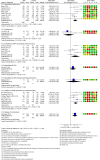Effectiveness of text messaging interventions on prevention, detection, treatment, and knowledge outcomes for sexually transmitted infections (STIs)/HIV: a systematic review and meta-analysis
- PMID: 30621784
- PMCID: PMC6323863
- DOI: 10.1186/s13643-018-0921-4
Effectiveness of text messaging interventions on prevention, detection, treatment, and knowledge outcomes for sexually transmitted infections (STIs)/HIV: a systematic review and meta-analysis
Abstract
Background: Rates of STIs continue to rise worldwide, and novel evidence-based interventions such as text messaging aimed at improving client services are needed. We conducted a meta-analysis to evaluate text messaging to support STI/HIV prevention and treatment interventions.
Methods: We included articles that reported findings from randomized controlled trials (RTCs) involving adults and youth who were at risk of acquiring (or who currently had) a STI and/or HIV, a text message and comparator intervention, and reported provided outcome data on adherence to STI/HIV treatments. Articles were excluded if they were not published in English. We only included studies that have full-text publications so certainty and risk of bias assessments could be performed. Eight databases were searched to retrieve articles published between 1996 and March 2017. The Cochrane risk of bias tool was used and certainty of the evidence was assessed using GRADE. Effect estimates were pooled using a random effects model.
Results: A total of 35 RCTs were found, 6 of which were considered at low risk of bias. Eight studies found an increased association using text messaging in appointments attended compared to standard care (OR 1.64, 95% CI 1.28 to 2.10). Participants receiving text messages had an increase in HIV testing compared to standard care (n = 6; OR 1.73, 95% CI 1.39 to 2.15). Ten text messaging RCTs measuring adherence using micro-electro-mechanical systems (MEMS) pill counts has a non-significant association (OR 1.17, 95% CI 0.95-1.45) while five studies measuring adherence by self-report was found to be significant (OR 1.64, 95% CI 1.28-2.11).
Conclusions: The effectiveness of text message interventions is equivocal. While text messaging has the potential to enhance the delivery of STI/HIV interventions, program planners are encouraged to evaluate any SMS intervention to ensure it is achieving the desired result.
Systematic review registration: PROSPERO CRD42013006503.
Keywords: Delivery of health care; Evidence-based medicine; Meta-analysis; Sexually transmitted diseases; Text messaging.
Conflict of interest statement
Consent for publication
Not applicable
Competing interests
Dr. Richard Lester (RL) has financial as well as professional interests in WelTel mHealth Society (non-profit organization) and WelTel Incorporated (private company). These two organizations develop the WelTel SMS technology platform. RL was an author of one of the included RCTs, but did not extract data and did not analyze the data. No other authors were authors of any of the included RCTs, and have no competing interests.
Publisher’s Note
Springer Nature remains neutral with regard to jurisdictional claims in published maps and institutional affiliations.
Figures




References
-
- World Health Organization. Sexually transmitted infections (STIs): Key facts. 2016 [cited 2018 Jul 17]. Available from: http://www.who.int/news-room/fact-sheets/detail/sexually-transmitted-inf....
-
- BC Centre for Disease Control. STI annual report. 2015. Vancouver: BC Centre for Disease Control; [cited 2018 Jul 15]. Available from: http://www.bccdc.ca/resource-gallery/Documents/Statistics%20and%20Resear...
-
- Kirby Institute . HIV, viral hepatitis and sexually transmissible infections in Australia: annual surveillance report. Sydney: Kirby Institute, UNSW; 2017.
-
- Abara WE, Hess KL, Neblett Fanfair R, Bernstein KT, Paz-Bailey G. Syphilis trends among men who have sex with men in the United States and Western Europe: a systematic review of trend studies published between 2004 and 2015. PLoS One. 2016;11(7):e0159309. doi: 10.1371/journal.pone.0159309. - DOI - PMC - PubMed
-
- Executive Summary. Report on sexually transmitted infections in Canada: 2009. Ottawa: Government of Canada; 2009 [cited 2018 Jul 17]. Available from: https://www.canada.ca/en/public-health/services/infectious-diseases/surv...
Publication types
MeSH terms
Grants and funding
LinkOut - more resources
Full Text Sources
Medical
Molecular Biology Databases

